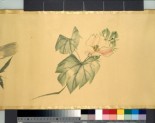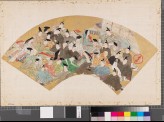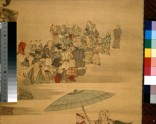Japanese Paintings in the Ashmolean Museum
A catalogue of the Ashmolean's collection of Japanese paintings by Janice Katz (published Oxford, 2003).
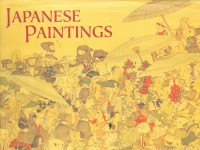
The nineteenth century has been termed ‘the age of true depiction’ [1], or the age of the shasei (sketch). Shasei based on the direct observation of life, became the basic element in conceiving compositions, and for the first time were used to compose large-scale works such as hanging scrolls, screens and sliding doors. Though not by any means the first to draw actual nature, Maruyama Ōkyo (1733-1795) was a pioneer who used his knowledge of Western perspective and visual realism to construct his paintings. As the founder of the Maruyama school, Okyo can effectively be called the father of all four shasei schools included in this section: the Maruyama, Mori, Shijō and Kishi schools.
Ōkyo became an apprentice to a Kano workshop in Kyoto at least by his teens. There he learned the school’s fusion of Chinese-inspired ink painting and more native Yamato-e traditions of the Tosa school. Early works by the artist include megane-e, pictures made to be viewed through lenses to give a panoramic view of a certain scene. For many of these works, Ōkyo used a heavily shaded, Western- inspired construct that he saw in Chinese prints from the Suzhou area. These were perhaps his first introductions to depicting Western-style perspective and volumetric realism. The availability of scientific texts on botany and medicine fuelled a trend for objective observation and recording of flora and fauna. Against this background, Ōkyo set about making careful drawings of insects and birds, as in his notebook Shasei zatsurokujō (Album of Various Sketches) (c. 1771). Included are sketches of creatures he observed in nature, as well as notes on paintings, illustrations or interesting designs he came across. His most well- known book of sketches is the Konchū shaseichō (Album of Sketches of Insects) (1776). It should be noted that his sketches were not summary depictions of a view or the landscape around him, but detailed studies of various creatures.
No works by Maruyama Ōkyo are featured in this catalogue. However, the second generation of artists of the Maruyama school, made up of the most talented of Ōkyo’s pupils, is well represented. After Ōkyo’s death, his son Ōzui [EA1973.156] assumed the headship of the family. Maruyama Ōshin [EA1973.92] and Kunii Ōbun [EA1973.90 and EA1973.91] held the title in turn, and kept the large group of followers in contact and the school’s treasure trove of shasei intact. Of Ōkyo’s direct pupils, Nagasawa Rosetsu, Oku Bunmei [EA1973.18], Yamaguchi Soken [EAX.5366], and Mori Tetsuzan [EA1962.209] continued to work primarily in Kyoto. Rosetsu, however, left the studio to develop into one of the most individual painters in Japanese art. Rosetsu’s Yama-uba [EA1973.96] fan painting in the Ashmolean reflects his penchant for the more bizarre figures of Japanese legend. Another of Ōkyo’s pupils, Watanabe Nangaku, ventured to Edo where he became a personal ambassador for the new style. His Beauty and Skull [EA1973.187] is one of the artist’s masterpieces, published here for the first time since 1932. The history of the Mori school of artists is intertwined with that of the Maruyama school. Mori Tetsuzan’s uncle, Sosen (1747-1821), its founder, was active in Osaka and famous for his lifelike depictions of monkeys. Though Tetsuzan went to Kyoto to join Ōkyo’s studio, many Mori school painters, including Tetsuzan’s father Shūhō, were active in Osaka and appear in the Ashmolean’s Calligraphy and Painting Album of 1799-1805 [EA1964.95], a veritable who’s who of artists in that city.
The Maruyama school's patrons were the wealthy merchant class in Kyoto as well as the imperial family, and were involved in many of the largest-scale commissions of the day. For example, from 1787 to 1795, Ōkyo and his pupils set about executing a decorative program for Daijoji temple in Hyōgo. Ōkyo, Soken, Rosetsu, and Tetsuzan were all involved in painting sliding doors with legendary subjects as well as birds and animals [2]. Many of the artists involved in that project are represented in the Ashmolean’s collection.
Matsumura Goshun, founder of the Shijō school of artists, was a native of Kyoto born into a wealthy family. His father was an official in the mint, and he worked there for a time before leaving to pursue painting. He became the main pupil of Yosa Buson (1716-1783), famed for his haiga (haiku paintings), with whom he studied Nanga painting and poetry. After a series of family losses in 1781, Buson recommended that Goshun travel to Ikeda in Osaka. This would prove a turning point in his career. Sometime during his time in Ikeda, Goshun began to experiment with the Maruyama manner, and in 1789 he moved to Kyoto, perhaps on the advice of Ōkyo. Though he worked on commissions with Ōkyo, at Daijōji, for example, he continued to be viewed mainly as an independent artist. Among his later works, the Ashmolean's painting of the elderly couple Jo and Uba [EA1973.162] shows Goshun’s affinity and sensitivity to poetry. Goshun’s style was softer, more lyrical than that of Ōkyo. His new manner spread throughout Kyoto, and beyond, and was known as the Shijō school, after the location of his studio. Subsequent generations of the school remained clustered around Shijō (Fourth avenue): Shibata Gitō [EA1973.171], Yokoyama Seiki [EA1973.191] and Hishida Nittō [EA1973.89]. Watanabe Nangaku’s pupils, Suzuki Nanrei [EA1973.116] and Onishi Chinnen [EA1973.132 and EAX.5426], practised the Shijō manner in Edo. Able to capture the personality of a figure or the character of a flower with an economy of ink and a breathtaking colour sense, they represent the height of the Edo Shijō style.
Hirada Gyokuon, the only female painter featured in this catalogue, received the scholarly training typical of the Nanga school, but her paintings, such as Obon Festival [EA1973.136], have more in common with the Maruyama-Shijō school, taking subjects from the world around her.
The last school of the four is the Kishi school founded by Kishi Ganku, the famous painter of tigers from Echizen. Kishi Ganryō was his adopted son, and takes up his father's method of using agitated brushstrokes in his portrait of Renshōbō [EA1973.165]. Shibata Zeshin [EA1973.111, EA1973.176, and EA1966.161], who combined his knowledge of painting and lacquer both figuratively and literally, and Nakajima Yūsho [EA1973.184] brought the Shijō school into the Meiji period.
Nanga painters such as those featured in the previous section did not, in general, look kindly upon the new style that was nourishing in Kyoto. They believed that although Ōkyo and Goshun’s skill at representing realistic elements was truly magnificent, ‘their painting is not worth being emulated, or even appreciated' [3]. This was probably a reaction to the style’s widespread appeal, for it did not require the study of Chinese theoretical texts or ancient masters, nor the cultivation that they engendered.
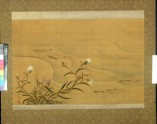 Sweetfish in a stream with pinks on the shore (EA1973.156)
Sweetfish in a stream with pinks on the shore (EA1973.156)
 Carp swimming in clear water (EA1973.144)
Carp swimming in clear water (EA1973.144)
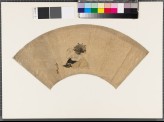 The pot-wearing saint (EA1973.92)
The pot-wearing saint (EA1973.92)
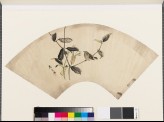 Sparrow on an akebi plant (EA1973.90)
Sparrow on an akebi plant (EA1973.90)
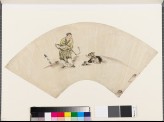 Kōshohei transforming a rock into a sheep (EA1973.91)
Kōshohei transforming a rock into a sheep (EA1973.91)
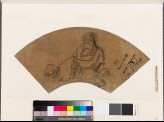 Yamanba and Kintarō (EA1973.96)
Yamanba and Kintarō (EA1973.96)
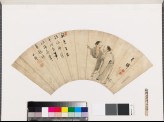 The sages Kanzan and Jittoku looking towards a poem (EA1966.99)
The sages Kanzan and Jittoku looking towards a poem (EA1966.99)
 Flowering gourd plant (EA1973.18)
Flowering gourd plant (EA1973.18)
 Bijin, or beautiful woman, with a skull (EA1973.187)
Bijin, or beautiful woman, with a skull (EA1973.187)
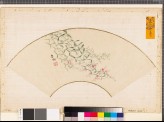 Flowering pink bush clover, or hagi (EAX.5366)
Flowering pink bush clover, or hagi (EAX.5366)
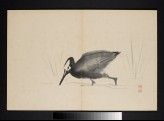 Album of figures, plants, and animals (EA1962.209)
Album of figures, plants, and animals (EA1962.209)
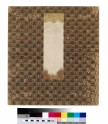 Album of Calligraphy and Paintings, and its box (EA1964.95)
Album of Calligraphy and Paintings, and its box (EA1964.95)
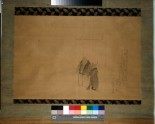 The characters Jo and Uba from the play Takasago (EA1973.162)
The characters Jo and Uba from the play Takasago (EA1973.162)
 Tachibina dolls in the dress of Heian-period courtiers (EA1973.171)
Tachibina dolls in the dress of Heian-period courtiers (EA1973.171)
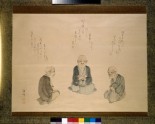 Three old men thinking about death (EA1973.191)
Three old men thinking about death (EA1973.191)
 Kōshohei transforming a rock into a sheep (EA1973.89)
Kōshohei transforming a rock into a sheep (EA1973.89)
References
[1] Sasaki Jōhei uses the term shinsha no jidai in the introduction to Minamoto Toyomune and Sasaki Johei, eds, Kyoto gadan no jūkyūseiki, vol. 2 Bunka Bunseiki (Kyoto: Shibunkaku shuppan, 1994), 8.
[2] Kokka 945 (1972), ‘The special number for the studies of the pictures of several painters of the Maruyama-Shijō School that remain at the Daijō-ji Temple'. Kokka 945 (1972) and Jōhei Sasaki, ‘Maruyama Ōkyo to Daijōji, shinsutsu bunsho o te gakari to shite (Maruyama Ōkyo and the Daijōji, a study based on newly discovered documents'. Kokka 1205 (1996), 3-18.
[3] Tanomura Chikuden, translated in Wylie, 274 (C: XXIII).
Notice
Object information may not accurately reflect the actual contents of the original publication, since our online objects contain current information held in our collections database. Click on 'buy this publication' to purchase printed versions of our online publications, where available, or contact the Jameel Study Centre to arrange access to books on our collections that are now out of print.
© 2013 University of Oxford - Ashmolean Museum

